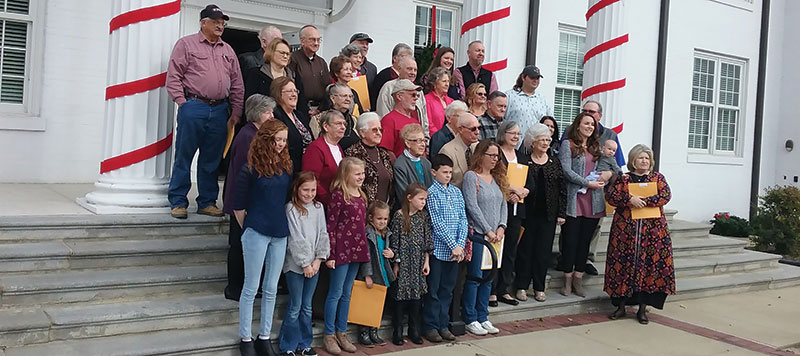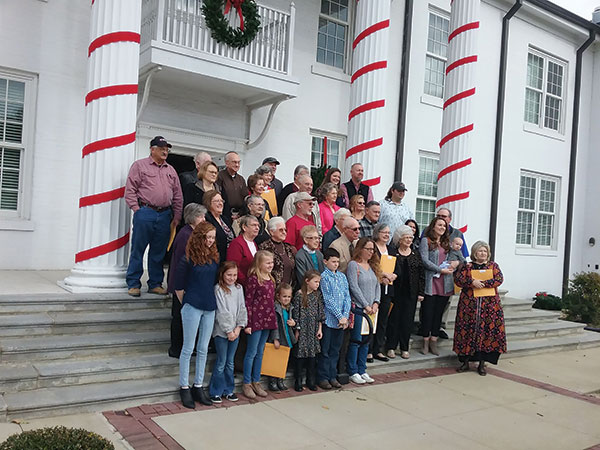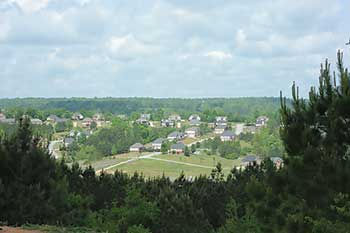
A Life in the Skies
Story by Carol Pappas
Photos by Michael Callahan
Submitted photos
When Jack Fincher and sister, Linda Wood, were growing up in Roebuck, John Donalson’s family lived across the street. Donalson was the first director of aviation for Alabama and after settling into the suburban Birmingham neighborhood, the family lived at the nearby airport in an apartment above his office.

That was before World War II. After the war, he commanded the Air National Guard for the state, was among the inaugural inductees to Alabama’s Aviation Hall of Fame, patented a steel casting process and became a steel company executive.
But what happened in between is the real story, said Fincher and Wood, both of whom now live in Pell City.
Fincher refers to the decorated war hero simply as “Papa.” In later years, Donalson’s wife and Fincher and Wood’s father passed away, and three years after Donalson’s wife died, “he came out here and proposed” to their mother, Almeda “Boots” Hines Fincher.
She had been a nurse and took care of Mrs. Donalson in her final days. Their spouses died a few months apart in the same year.
Humble hero
Fincher and Woods’ story about ‘Papa’ is deeply rooted in those in-between years when Lt. Col. John Donalson led the main airborne invasion of Normandy – D-Day – 75 years ago. More than 800 C-47s dropped over 13,000 paratroopers into the epic battle that would change the course of World War II and history. And Donalson was the commander.
A photo in his hometown newspaper in Birmingham captured the moment back home, his wife, Blanche, his three children, Beverly, 16, and John Jr. and Eugenia – just toddlers – listening to the broadcast of the invasion on radio in the early morning hours of June 6, 1944. The youngest, John Jr., is seen clutching a photograph of his father.
They may not have been able to understand the events as they unfolded in real time, but Daddy would come home with a chest full of medals and would rise to the rank of Major General.
That’s All, Brother

In the years that followed, the plane that took the lead in the invasion, That’s All, Brother, had gone from its pivotal role in D-Day to a post-war commercial stint to a scrap metal yard when it was salvaged, restored and began its journey anew to Normandy for the 75th Anniversary of D-Day, June 6, 2019.
As part of the Commemorative Air Force Central Texas Wing, That’s All Brother joined 15 other C-47/DC-3 airplanes to retrace the ferry path – United States to Canada to Greenland to Iceland to Scotland to England. In Duxford, England, That’s All Brother and three other planes headed to Normandy to commemorate the anniversary. Then it was on to Germany to commemorate the 70th anniversary of the Berlin Airlift.
In 1945, the historic aircraft was sold to the civilian market and over the next few decades and through multiple owners, it finally was sold to be scrapped in what the Commemorative Air Force described as “a boneyard in Wisconsin.”
As fate has a way of intervening, two historians from the United States Air Force discovered its whereabouts, the CAF acquired it, and through a Kickstarter program, donors and volunteers, That’s All Brother is flying once again.
Fincher was one of those donors and when That’s All Brother landed in Birmingham in May, Fincher and members of his family boarded for a trip of a lifetime. “I was stoked,” said Fincher. “Everybody sat on little tin seats and buckled up with the original equipment.”
He and members of his family were able to experience a step back into time when Papa flew the skies over Normandy. Members of Donalson’s family did as well, aboard a later flight.
After takeoff, passengers could wander around the airplane and cockpit, which had been fully restored to its 1944 look and condition. “It was like brand new,” Fincher said, noting that not a detail was missed. The original paint scheme, even surplus parts from 1944 were used in the restoration project.
“Papa was the command pilot,” he noted. “There were 82 airplanes in his command.” He selected the name, That’s All Brother, “as a message to Hitler.” The actual pilot that day was David Daniels, also from Birmingham, with Donalson aboard in command of the entire operation. Also aboard that day was a Scottie dog, the pilot’s pet. A stuffed dog to commemorate him is on the present-day flights.
“Papa’s plane was Belle of Birmingham,” Fincher said, “but because a radar beacon was required to be installed underneath the lead aircraft, Papa was loathe to cut a hole in the belly of his beloved ‘Belle,’ so he made the switch.”
Looking back
Wood and Fincher pore over old newspaper clippings and a scrapbook as tall as a three-layer cake. The sense of history and heroism, intertwined, is ever present as they turn each page.
They talk of Donalson’s flight with 80 more planes over the English Channel that fateful night with no lights, no radio.
Wood recently discovered his memoirs – 100 pages handwritten in pencil. In typical form of what has been called the Greatest Generation, “there was very little about D-Day,” she said.
In his own words
But in the family scrapbook is the copy of an official report Col. Donalson filed on June 6, 1944, where he had this to say about the day’s mission:
Our second mission consisted of fifty Gliders, thirty-six English Horsa and fourteen American CG-4A gliders.
All were marshalled, that is placed in a double row with tugs attached, so that they were able to take off starting from the front, one tug and glider every 25 to 30 seconds. We put the CG-4A in front because they could get off better. They were led by Maj. Gates who was to form over the field at 1800 feet and wait until all the Horsas were off and formed at 1200. Lt. Col. Daniel and myself were in the first tug with Horsa. Cawthon was all over the sky trying to keep it trailing. We formed up and got on course a little early in order to make our departure point on time. When we passed Cherbourg on our way in, it was quiet as a church-mouse. Guess they used up all their ammunition the night before. Off to our left, the surface convoy was stretched as far as you could see with boats going to the beaches.
There were a line of battleships and cruisers laying off the shore, all quiet at the moment, but waiting to silence any shore battery that was there and headed for our DZ. I had given all the preparatory light signals and was just ready to give the signal for cutting loose when Capt. Cawthon, the Glider Pilot, recognized his field and cut.
We pulled ahead, dropped our tow rope, and turned to head for our base when some Krauts with tommy guns started hitting us. One explosive shell came through and wounded our Radio Operator and Crew Chief. We hit the deck and started home. On the way back, I was checking to see how many planes we had lost. I could account for all but two. One of those had to re-service before he could make it in. The other made a crash landing in France and the crew got back in a couple of days.
My hat is off to the Glider pilots for they did a marvelous job under fire. They landed right on top of the front line with snipers all over the place. As soon as they got on the ground, they were in crossfire from machine guns and the Krauts had their mortar zeroed on the fields. The Glider pilots started returning the following day and are still coming in. So far we have definite proof that three have been killed and feel sure that three more were killed but cannot confirm it yet. Half of our airplanes were hit with small arms fire with the majority of hits in the engine and gas tanks. They are not leak-proof either.
This was our second mission and they were both 100 percent perfect. Considering the number of people involved in the operation, it is almost beyond belief that everyone would do exactly as he should.
There is not much of a report to make on these missions except all went according to plan.
We were the third group in and when we got back to the DP we were still meeting groups on their way in.
The boys are all on the peg awaiting a chance to go back on another mission and getting ants in their pants.
The memoir
Donalson’s memoir comes from a unique vantage point of the days leading up to the invasion as only he could tell it.
When I got to our field in central England, it frightened me that I would be responsible for everything on the field. They had fields all over England and if you became lost, you got on the radio and said Darkey, and a field would give you a course to fly to the field that you wanted to go to.
These were low output radios that you had to be near the field broadcasting to hear them. The first time the airplanes were out on familiarization flight, about twelve got lost over the North Sea.
Maj. Gen. Ridgeway, in command of the 82nd Airborne Division, was pressing me for a practice jump for his men. Brig. Gen. Gavin, his executive officer, was very impatient I made them wait 3 or 4 days while the pilots became familiar with flying at night over England…
I went with Gen. Ridgeway in his car to the drop zone about 10 miles from the point of take off, and the formation arrived at the prescribed time. Just after daylight we stood on the drop zone and had to dodge helmets and equipment falling. One man broke his leg landing on a frozen river. This drop pleased Gen Ridgeway since the old units returned from North Africa had dropped his outfit in a bombing practice area. I believe that was when he picked the 438th to lead the invasion on France.
The night before
In his memoir, Donalson writes about the night before when a Baptist minister gave a pep talk. …he evidently thought everyone was afraid they would be killed…
I followed with my talk and told the men that they were going to attend the greatest show on earth, and they had earned their ring side seat.
D-Day arrives
D-Day was scheduled for the 5th of June and had to be postponed on account of high wind over the channel. We painted three broad white stripes on each wing with three stripes around the fuselage on the night of June 4th. This was done to prevent a repeat of the invasion of Sicily, where the Navy shot some of the Allied airplanes down.
When Gen. Eisenhower cancelled the invasion on the 5th, no one thought to advise the men and women in the office. Someone notified the American press that the invasion had started and with the difference in time, it hit the headlines in the U.S.A. on the 4th.
We had beefed up until we had 18 airplanes in each squadron…which gave us 81 airplanes. Actually two groups.
We had enough brass to line up along the runway for half its length. Gen Eisenhower had been shaking hands with all the paratroops. Lt. Gen. Brereton was in the lead airplane talking to the paratroops. When I was ready to taxi into position for takeoff, I had to ask him to get out as it was time to move out.
We took off and formed over the field waiting for the second half to get into position for takeoff. This was a little before dark. I had split the group in two. I guess you could say 438th A and 438th B…We flew over the channel over a boat off the coast of Normandy. He flashed us an O.K. with his light in the shape of a cross. Also they had rolls of aluminum tape that could be picked up by the German radar to confuse into thinking the landing was to be made at some other place…
Our two sections dropped their paratroops about ½ mile from each other. Gen. Gavin wrote us up for not dropping his units in the same place. We cut our throttles and glided down to 400 ft. to let the paratroopers jump. As soon as the paratroops were all out, we gave the engines full throttle and climbed to 3000 ft. flying over incoming planes.
Coming home
Donalson came home to Birmingham, returning to a life in the steel industry, Air National Guard and with his family, not talking much about the war except in interviews with media wanting to know more about this hometown hero.
In a television interview after returning to Birmingham, Wood said the colonel described the unprecedented air power that filled the sky that day in simple, but vivid terms: “You could damned near walk from one airplane wing to another.”
A newspaper account from Birmingham when he was home on leave paints a picture of Donalson, the man. “Calm in manner and voice, the Birmingham colonel has eyes that penetrate. Their grayness have the flash, the sharpness of tempered steel…
“He wears the distinguished flying cross with two oak leaf clusters, also the Presidential group citation. Three battle stars are on his ETO ribbon.”
“Your family were pretty glad to see you weren’t they?,” he was asked. “And the colonel—who made history on D-Day—answered as you or anyone else might have answered, ‘Yeah.’ ”
About the man
An engineering graduate from Georgia Tech in the 1920s, he was an engineer for Connors Steel before and after the war. His diploma, Fincher said, “is on a real sheepskin.”
He later formed his own steel company, and he patented his continuous steel casting formula. He and “Boots” lived happily 10 years in Trussville and two years in Pell City until his death in 1987. “They were well suited for each other,” said Fincher.
“Papa was very close to us,” added Wood. “He loved us dearly, and we loved him. He was the only grandfather my kids ever knew.”
“I think Papa’s modesty prevented our knowing more about his historic actions,” added Fincher. “A natural leader: courageous, capable. It makes me wish we had more like him around today. It’s my privilege to have known him and called him, Papa.”



























